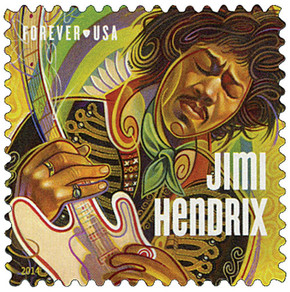
U.S. #5059
2016 49¢ Sarah Vaughan
Music Icons Series
Though she didn’t have formal training, Sarah Vaughan’s three-octave range and rich vibrato made her a jazz and pop superstar.
Vaughan (1924-90) had a love of music from an early age. Both her parents were part-time musicians and she sang frequent solos in her church choir. In 1942, Vaughan entered a talent contest at Harlem’s Apollo Theater on a dare. She won – both the contest and the attention of singer Billy Eckstine.
Vaughan’s career took off, singing with big bands before going solo. Early on, she developed a unique style, which emulated the sounds of the trumpet and saxophone, that became her hallmark. Vaughan was nicknamed “Sassy” for her playful onstage presence, and dubbed “The Divine One” by a Chicago DJ.
Vaughan became one of the nation’s most acclaimed singers with hits like “Whatever Lola Wants,” “Misty,” and “If You Could See Me Now.” Her concerts were emotional and captivating, earning her invitations to perform at the White House and Carnegie Hall.
In a career spanning five decades, Vaughan received many awards, including a Lifetime Achievement Grammy, a star on the Hollywood Walk of Fame, and induction into the Jazz Hall of Fame. As one music critic put it, she had “one of the most wondrous voices of the 20th century.”
Value: First-Class Mail Forever
Issued: March 29, 2016
First Day City: Newark, NJ
Type of Stamp: Commemorative
Printed by: Ashton Potter
Method: Offset, Microprint – “USPS” in Panes of 16
Self-Adhesive
Quantity Printed: 25,000,000
Death of Erroll Garner
Jazz pianist and composer Erroll Garner died on January 2, 1977, in Los Angeles, California. He’s been called “one of the most distinctive of all pianists” and a “brilliant virtuoso.”
Erroll Louis Garner was born June 15, 1921, in Pittsburgh, Pennsylvania. He was the youngest of six children and had a twin brother, Ernest. Blessed with a natural talent, he began playing the piano by ear at age three. Although he never received any formal training, and was never able to read or write music, Garner was able to play any song – even if he’d heard it only once!
At age seven, Garner was playing piano for a radio program, and by eleven, he was a piano player on the Allegheny riverboats. Garner started performing with local bands in 1937. He moved to New York City at age 23 and began playing clubs on 52nd Street, including the Three Deuces and Tondelayo’s. His unique piano styling was featured on recordings by the Slam Stewart Trio before he recorded under his own name with a bassist and drummer. From 1945 to 1949, Garner made a number of records on a freelance basis before signing an exclusive contract with Columbia Records. In 1948 he performed at the Paris Jazz Festival. He also played with Charlie Parker on the 1947 Cool Blues session.
Garner’s music appealed to non-jazz audiences, and he enjoyed great success in the late 1950s. His 1955 live album Concert by the Sea was a best-selling jazz album. He toured Europe in 1957 and ’58. Garner was a frequent guest on Johnny Carson’s Tonight Show, and was reportedly the host’s favorite jazz musician. His most famous song “Misty” was a big hit in 1959 and enjoyed a resurgence in 1971, when it became the theme song for the Clint Eastwood film Play Misty For Me. He is also remembered for the songs “It Gets Better Every Time,” “Dreamy,” “Nightwind,” “La Petite Mambo,” and “Equinox.”
Even as an adult, Garner was short (5 feet, two inches) and played the piano sitting on several telephone books. Since he had small hands, his dazzling ability at rapid keyboarding was even more impressive. He frequently used a style known as “gas pedaling,” in which he would play melodies with his right hand behind those played by his left, eventually speeding up the tempo to catch up to his left hand.
Garner was also known for his vocalizations while playing, and these can be heard on many recordings. Jazz writer Scott Yanow called Garner “one of the most distinctive of all pianists.”
Garner suffered from emphysema and died of cardiac arrest on January 2, 1977, in Los Angeles, California. A film about his life, No One Can Hear You Read, was released in 2012. The film’s title is a phrase Garner used to say when people asked why he never learned to read music.














